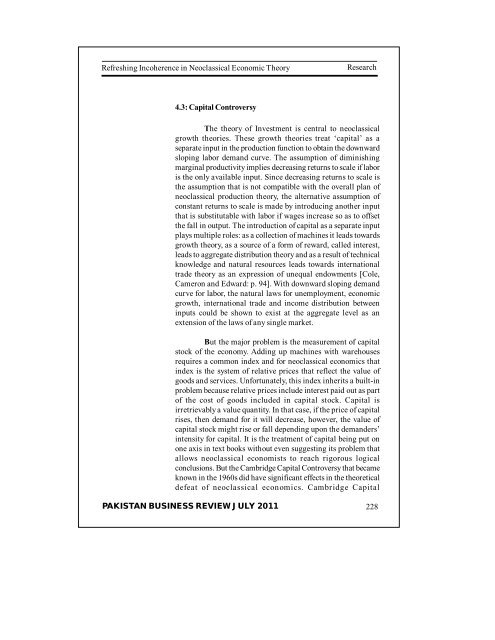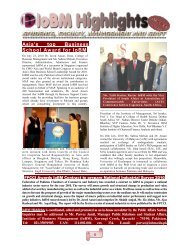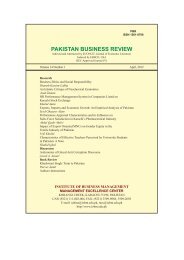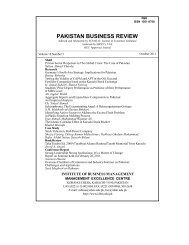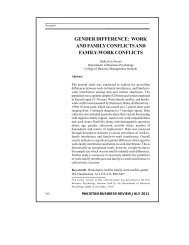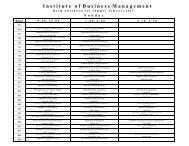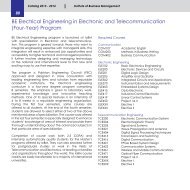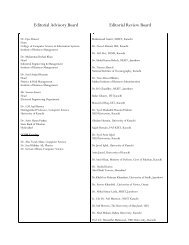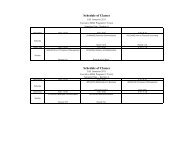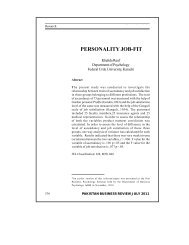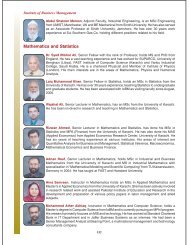PAKISTAN BUSINESS REVIEW - Institute of Business Management
PAKISTAN BUSINESS REVIEW - Institute of Business Management
PAKISTAN BUSINESS REVIEW - Institute of Business Management
Create successful ePaper yourself
Turn your PDF publications into a flip-book with our unique Google optimized e-Paper software.
Refreshing Incoherence in Neoclassical Economic Theory<br />
Research<br />
4.3: Capital Controversy<br />
The theory <strong>of</strong> Investment is central to neoclassical<br />
growth theories. These growth theories treat ‘capital’ as a<br />
separate input in the production function to obtain the downward<br />
sloping labor demand curve. The assumption <strong>of</strong> diminishing<br />
marginal productivity implies decreasing returns to scale if labor<br />
is the only available input. Since decreasing returns to scale is<br />
the assumption that is not compatible with the overall plan <strong>of</strong><br />
neoclassical production theory, the alternative assumption <strong>of</strong><br />
constant returns to scale is made by introducing another input<br />
that is substitutable with labor if wages increase so as to <strong>of</strong>fset<br />
the fall in output. The introduction <strong>of</strong> capital as a separate input<br />
plays multiple roles: as a collection <strong>of</strong> machines it leads towards<br />
growth theory, as a source <strong>of</strong> a form <strong>of</strong> reward, called interest,<br />
leads to aggregate distribution theory and as a result <strong>of</strong> technical<br />
knowledge and natural resources leads towards international<br />
trade theory as an expression <strong>of</strong> unequal endowments [Cole,<br />
Cameron and Edward: p. 94]. With downward sloping demand<br />
curve for labor, the natural laws for unemployment, economic<br />
growth, international trade and income distribution between<br />
inputs could be shown to exist at the aggregate level as an<br />
extension <strong>of</strong> the laws <strong>of</strong> any single market.<br />
But the major problem is the measurement <strong>of</strong> capital<br />
stock <strong>of</strong> the economy. Adding up machines with warehouses<br />
requires a common index and for neoclassical economics that<br />
index is the system <strong>of</strong> relative prices that reflect the value <strong>of</strong><br />
goods and services. Unfortunately, this index inherits a built-in<br />
problem because relative prices include interest paid out as part<br />
<strong>of</strong> the cost <strong>of</strong> goods included in capital stock. Capital is<br />
irretrievably a value quantity. In that case, if the price <strong>of</strong> capital<br />
rises, then demand for it will decrease, however, the value <strong>of</strong><br />
capital stock might rise or fall depending upon the demanders’<br />
intensity for capital. It is the treatment <strong>of</strong> capital being put on<br />
one axis in text books without even suggesting its problem that<br />
allows neoclassical economists to reach rigorous logical<br />
conclusions. But the Cambridge Capital Controversy that became<br />
known in the 1960s did have significant effects in the theoretical<br />
defeat <strong>of</strong> neoclassical economics. Cambridge Capital<br />
<strong>PAKISTAN</strong> <strong>BUSINESS</strong> <strong>REVIEW</strong> JULY 2011<br />
228


